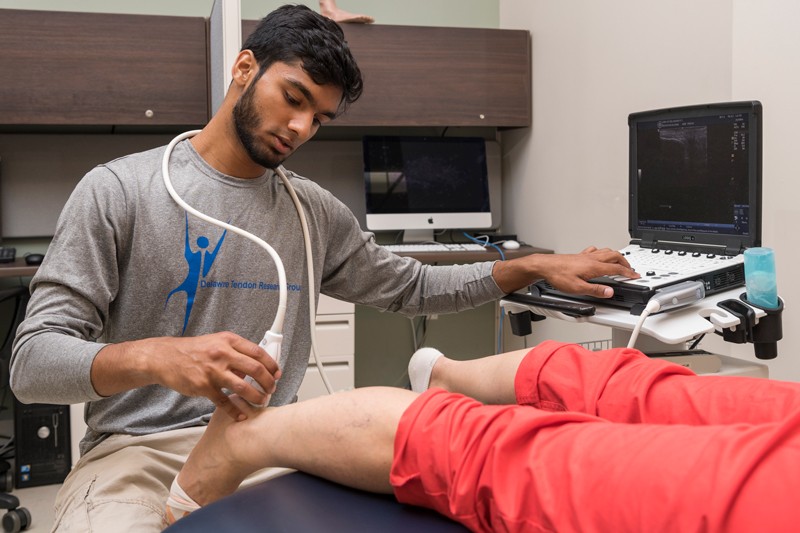UD Summer Scholar studies properties of Achilles tendons
Editor’s note: Research, community service, internships and study abroad were part of the summer for University of Delaware students. Follow them in action in our series of profiles and stories, which will be collected on the Driven to Discover website.
Arif Peracha, a senior from Newark, Delaware, is majoring in biomedical engineering. A McNair Scholar and triathlete, he was one of more than 500 students doing research across UD during the summer of 2019.
Q. What have you been studying this summer?
Peracha: I am at the STAR (Science, Technology and Advanced Research) Campus, working in the Muscle and Tendon Performance Lab with Dr. Karin Silbernagel, associate professor of physical therapy. My project is studying whether leg dominance is correlated with different mechanical properties of the Achilles tendon in healthy subjects, such as how stiff it is and how well it behaves like a spring in response to forces. As the Achilles tendon responds at the cellular level to forces and loading to heal, reinforce itself and improve its mechanical properties, it may be possible that consistently using a dominant leg for tasks could have formed differences between the dominant to nondominant side.
Q. What inspired this project and what interests you most about it?
Peracha: As a runner, the fact that Achilles tendinopathy is a very common occurrence in runners makes the Achilles tendon a topic of interest for me. I also aspire to be a physical therapist and — dreaming big — if this research helps clinicians better understand how important limb dominance is to the Achilles tendon it may aid in making decisions about when people should be cleared for activities after Achilles tendinopathy. For example, if it is found that the dominant leg has stiffer properties in the tendon, a physical therapist may have to tell a soccer player who has injured the tendon on that side that it needs to be rehabilitated to better mechanical properties than the non-dominant side before the player can safely return to the field.
Q. What is a typical day like?
Peracha: A typical day consists of several subjects coming in so we can take ultrasound images of their tendons, measure their mechanical properties and test their ability to jump, hop, walk and perform heel rises (all tests that involve loading of the Achilles tendon). Around those data collections, we’re juggling time to process data, read research papers and prepare for our poster symposiums.
Q. What hurdles have you had to overcome while doing this work?
Peracha: One of the hurdles includes recruiting participants into the study. It took time getting comfortable with advertising the study and asking people to enroll. The work also requires a lot of flexibility, because multiple subjects can come in back to back and if the collections don’t go as planned, being able to adapt to the scenario to get quality data in a timely matter is crucial.
Q. What is the coolest thing you have experienced in this project?
Peracha: The coolest thing about working at the Muscle and Tendon Lab is being able to engage with people and show them what their muscles and tendons look like through the ultrasound. Everyone is very excited and interested in it.
Q. What has surprised you most?
Peracha: I’m surprised how much there still is to know about a common injury like Achilles tendinopathy.
Q. How would you describe this experience in one word?
Peracha: If I had to summarize my experience in one word, it would be “instructional.”
Q. What advice would you give younger students (middle/high school) with similar interests?
Peracha: I know it’s easy to feel unready to conduct research at this level but anyone with an interest can be involved. The first step is finding a lab involved with clinical research (there are many in the STAR health sciences complex) and then sending the email or making a phone call. There’s no need to feel awkward or nervous, the researchers here are very supportive and easy to talk to and once things are moving, you’ll learn the things you need to know as you go along.
Q. What do you enjoy when you are not doing research?
Peracha: When I’m not at work, I’m preparing for and competing in triathlons. I spend hours of my day on the roads, the trails, the pool and at the gym. I also enjoy volleyball, hiking, reading a little and napping in the sun more. I also volunteer at the physical therapy clinic at STAR a few times a week and try to absorb as much information from the physical therapists as I can.
Article by Beth Miller

